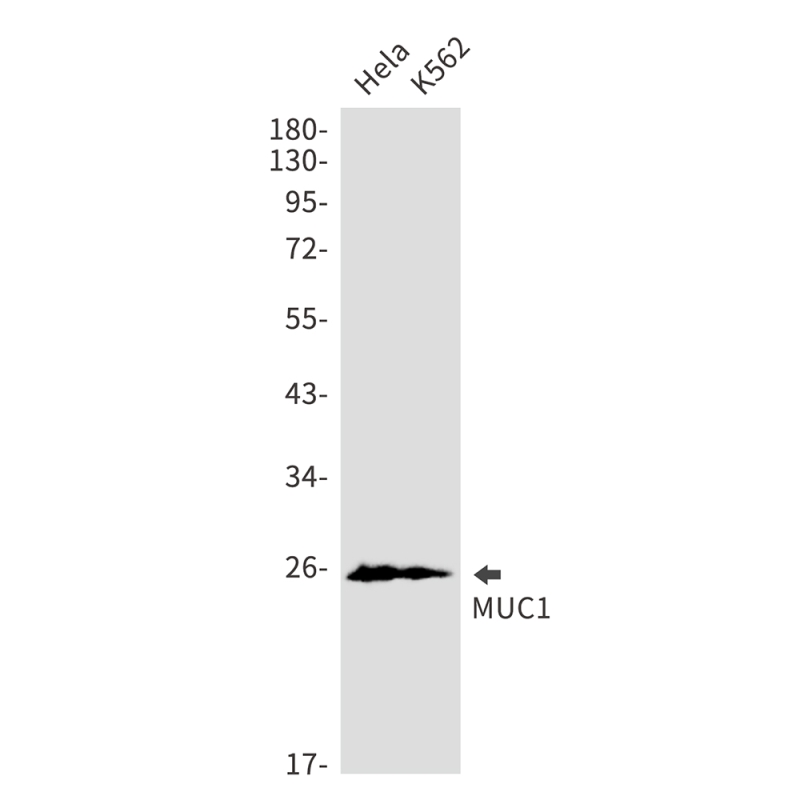
| WB | 1/500-1/1000 | Human,Mouse,Rat |
| IF | 1/20 | Human,Mouse,Rat |
| IHC | 1/50-1/100 | Human,Mouse,Rat |
| ICC | 1/50-1/200 | Human,Mouse,Rat |
| FCM | 咨询技术 | Human,Mouse,Rat |
| Elisa | 咨询技术 | Human,Mouse,Rat |
| Aliases | MUC1; PUM; Mucin-1; MUC-1; Breast carcinoma-associated antigen DF3; Carcinoma-associated mucin; Episialin; H23AG; Krebs von den Lungen-6; KL-6; PEMT; Peanut-reactive urinary mucin; PUM; Polymorphic epithelial mucin; PEM; Tumor-associated ep |
| Entrez GeneID | 4582 |
| WB Predicted band size | Calculated MW: 122 kDa; Observed MW: 25 kDa |
| Host/Isotype | Rabbit IgG |
| Antibody Type | Primary antibody |
| Storage | Store at 4°C short term. Aliquot and store at -20°C long term. Avoid freeze/thaw cycles. |
| Species Reactivity | Human |
| Immunogen | A synthetic peptide of human MUC1 |
| Formulation | Purified antibody in TBS with 0.05% sodium azide,0.05%BSA and 50% glycerol. |
+ +
以下是关于MUC1抗体的3篇代表性文献及其简要摘要:
---
1. **文献名称**:*Targeting MUC1-C inhibits the self-renewal capacity of breast cancer stem cells*
**作者**:Kufe, D.W. et al.
**摘要**:该研究开发了一种靶向MUC1-C端的新型单克隆抗体,通过抑制乳腺癌干细胞自我更新和诱导凋亡,证明其在体外和小鼠模型中可显著减少肿瘤生长,为MUC1-C靶向治疗提供依据。
---
2. **文献名称**:*Humanized anti-MUC1 antibodies for cancer imaging and therapy*
**作者**:Burchell, J. et al.
**摘要**:研究者构建了人源化抗MUC1抗体hCTM01.并验证其在卵巢癌和乳腺癌中的靶向成像能力。结果显示抗体可特异性识别肿瘤组织中异常糖基化的MUC1.为诊断和抗体药物偶联(ADC)奠定基础。
---
3. **文献名称**:*MUC1-specific chimeric antigen receptors for the adoptive immunotherapy of multiple myeloma*
**作者**:Posey, A.D. et al.
**摘要**:该研究设计了靶向MUC1的CAR-T细胞,在多发骨髓瘤模型中显示高效抗肿瘤活性,证实MUC1可作为免疫细胞疗法的有效靶点,并探讨了其临床转化潜力。
---
如需更多文献,可进一步限定研究领域(如诊断/治疗/机制)。
**Background of Mucin 1 Antibodies**
Mucin 1 (MUC1) is a transmembrane glycoprotein belonging to the mucin family, primarily expressed on the apical surface of epithelial cells in various tissues, including the respiratory, gastrointestinal, and reproductive tracts. It plays a critical role in cell signaling, lubrication, and protection. Structurally, MUC1 contains a variable number of tandem repeats (VNTR) in its extracellular domain, which undergoes heavy O-glycosylation under normal conditions.
In cancer, MUC1 is often overexpressed and aberrantly glycosylated, particularly in adenocarcinomas (e.g., breast, ovarian, pancreatic). The loss of normal glycosylation exposes novel epitopes, such as the tumor-associated Tn and sialyl-Tn antigens, making it a prime target for immunotherapy. MUC1 antibodies are designed to recognize these cancer-specific epitopes or the underglycosylated VNTR region.
Diagnostically, MUC1-targeting antibodies (e.g., CA15-3 assay) are used to monitor cancer progression. Therapeutically, monoclonal antibodies (e.g., Pemtumomab), antibody-drug conjugates (ADCs), and CAR-T cells exploit MUC1 antibodies for targeted tumor cell killing. Challenges include heterogeneity in MUC1 expression, glycosylation variability, and off-target effects. Ongoing research focuses on optimizing antibody specificity, developing bispecific constructs, and combining MUC1-targeted therapies with checkpoint inhibitors to enhance efficacy.
×